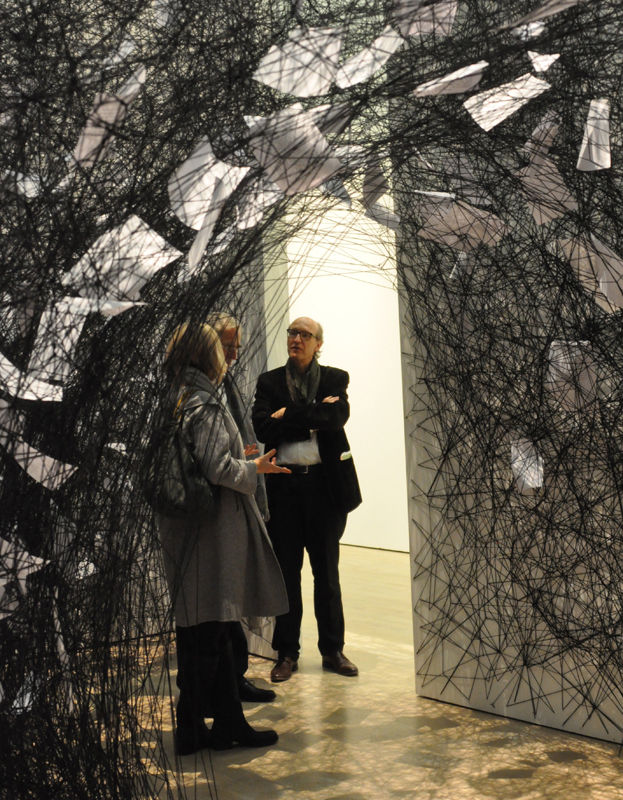
Textile art has always been a pariah of the art world. It was not ” spiritual ” enough , a charged field of employment for women, at most craft, loaded with too much material values and the sublime ideas unworthy. Since Ruskin and Morris, before and after the First World War there were Reform efforts , but these were repeatedly said and written small in their effect by the guardians of the holy grail of art, the academically trained art historians, as female design efforts as a secondary crafts or as phenomena of ethnographic origin.
That seems to change in recent times. Textiles appear more often as objects of reflection in art museum and gallery exhibitions, often commented in catalogs and accompanying books trying to introduce the values of textiles — with the means of the conservative understanding of art !
What has happened? If you ask the curators of such events, one gets the impression of helplessness. Some are fed up with the “ isms” of the 20th century, tired of interpretation follies of Fauv -ism (from 1905) to Minimal -ism (see also Hannu Castrén ). Others believe that today’s digital arts have contributed to a desensualization of art screaming for sensual experiences ( the woman as the intermediary!) .
Joanne Mattera , a US-American artist and in the early 1980s, editor of the Fiberarts magazine, a regular visitor to North American and European art fairs, as well as one of the curators of the exhibition ” Textility “, wrote in the Fall issue of the SDA journal under the title ” Fiber, Fiber Everywhere” that she felt the year 2009 as the turning point when the textile topic became dominant. Around five years ago, this fashionable art trend seemed to have prevailed in the art market, its excesses and perversions we described in TEXTILE FORUM 2 / 2013 on the example of Jacquard ” tapestries” as objects of the misunderstood textile phenomenon . This misunderstanding of textile art is currently spread by conservative art critics in their exhibitions and print products in various forms.
More recently, Seth Siegelaub known as a notable trader with antiquarian textile literature since the second half of the 1990s *) is identified by the representatives of the art market as the initiator of this new trend. His “Centre for Social Research on Old Textiles ( CSROT )” had become known in curator circles during the 2009 exhibition “Textiles Art and the Social Fabric” in the Antwerp Museum of Contemporary Art, unless they knew him already from an earlier time as an American conceptual art dealer , curator , author and scientist. Siegelaub had his textile collection exhibited in 2012 under the title ” The Stuff That Matters ” at Raven Row in London before he died 2013 in Basel.
The latter two exhibitions in Antwerp and London under participation of Seth Siegelaub, seem to have supplied the conservative art curators with the arguments needed to accompany the new trend ideologically, showing their authority to interpret the art for a middle class audience. Siegelaub as an autodidact and creative thinker had recognised the textile medium as a universal archetype of human life **), now frozen into a formula of faith by the guardians of the arts. The end of this trend is predictable.
Notes
*) TEXTILeFORUM 4/1998: ” Two notable textile bibliographers ” , p.24
**) Bibliogaphica Textilia Historiae
Ich bin froh, auf der Suche nach Informationen über die Kulturgeschichte des Textilhandwerks auf diese Seite gestoßen zu sein.
Diesen Standpunkt können wir voll und ganz unterstützen. Wir waren entsetzt, als im Fernsehen einer der bewussten Jacqardteppiche präsentiert wurde.
Neben der Weberei widme ich mich der Kulturgeschichte des Textilhandwerks, bezogen vor allem auf die Sprachgeschichte und auf die Volkskunde. Ich stoße dabei immer wieder auf Unverständnis und Nichtwissen, vor allem auch bei Menschen, die es wissen müssten. Woran das liegt? Eine Ursache ist die frühe Industrialisierung verbunden mit der Globalisierung, so dass textile Fasern und Produkte so billig sind wie noch nie. Die Fertigkeiten der Hand, das Bewusstsein für Qualität, die gestalterischen Fähigkeiten werden nicht mehr gebraucht und also auch nicht mehr ausgebildet. Man muss sogar aufpassen, dass man richtig zitiert wird!